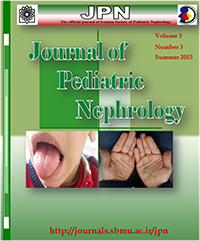Drug Rash with Eosinophilia and Systemic Symptoms (DRESS) Cause Interstitial Nephritis: a case Report and Review of Literatures
Journal of Pediatric Nephrology,
Vol. 3 No. 3 (2015),
6 July 2015
,
Page 116-120
https://doi.org/10.22037/jpn.v3i3.9366
Abstract
Drug Rash with Eosinophilia and Systemic Symptoms (DRESS) is a potentially life-threatening, complex, and multifaceted disease which may imitate other grave conditions. It presents with cutaneous drug eruptions, fever, hematologic abnormalities (an eosinophil count of 1500/mm3 or atypical lymphocytosis), and systemic involvement including hematologic, renal, pulmonary, hepatic, cardiac, gastrointestinal, neurologic, and endocrine abnormalities. Anticonvulsant therapies (mainly carbamazepine) are among the most important causative drugs.
Case report: Herein we present a10-year-old girl who developed skin rash, systemic symptoms, marked eosinophilia, and kidney involvement following anticonvulsive treatment with phenobarbital and sodium valproate. She experienced multiple hospitalizations due to an improper diagnosis and management.
Conclusion: Drug Induced Hypersensitivity Syndrome (DIHS) is a severe life-threatening disorder which mostly occurs due to aromatic anticonvulsive drugs. The disease may mimic other serious conditions and delay in the diagnosis and improper treatment may cause organ involvement and more severe outcomes.
Key words: Drug Hypersensitivity Syndrome; DRESS Syndrome; Drug Reaction with Eosinophilia and Systemic Symptoms; Drug Eruptions; Interstitial Nephritis.
How to Cite
References
Cacoub P, Musette P, Descamps V, Meyer O, Speirs C, Finzi L, et al. The DRESS syndrome: a literature review. The American journal of medicine. 2011;124(7):588-97.
Shiohara T, Kano Y, Takahashi R. Current concepts on the diagnosis and pathogenesis of drug-induced hypersensitivity syndrome. JMAJ. 2009;52(5):347-52.
Bocquet H, Bagot M, Roujeau JC, editors. Drug-induced pseudolymphoma and drug hypersensitivity syndrome (Drug Rash with Eosinophilia and Systemic Symptoms: DRESS). Seminars in cutaneous medicine and surgery; 1996: WB Saunders.
Husain Z, Reddy BY, Schwartz RA. DRESS syndrome: Part I. Clinical perspectives. Journal of the American Academy of Dermatology. 2013;68(5):693. e1-. e14.
Bourgeois GP, Cafardi JA, Groysman V, Hughey LC. A review of DRESS-associated myocarditis. Journal of the American Academy of Dermatology. 2012;66(6):e229-e36.
Schnyder B. Approach to the patient with drug allergy. Medical Clinics of North America. 2010;94(4):665-79.
Sin C, Mahé E, Sigal M-L. Drug reaction with eosinophilia and systemic symptoms (DRESS) in a patient taking sitagliptin. Diabetes & metabolism. 2012;38(6):571-3.
Baruzzi A, Contin M, Barbara G, Cremon C, De Giorgio R, Patrizi A, et al. Drug rash with eosinophilia and systemic symptoms secondary to phenobarbitone. Clinical neuropharmacology. 2003;26(4):177-8.
Rampur L, Jariwala S, Amin B, Patel P, Rosenstreich DL. Dress syndrome with suspected Strongyloides infection in a patient treated for hepatitis C. Annals of Allergy, Asthma & Immunology. 2013;2(111):138-9.
Kano Y, Shiohara T. The variable clinical picture of drug-induced hypersensitivity syndrome/drug rash with eosinophilia and systemic symptoms in relation to the eliciting drug. Immunology and allergy clinics of North America. 2009;29(3):481-501.
Cumbo‐Nacheli G, Weinberger J, Alkhalil M, Thati N, Baptist AP. Anticonvulsant hypersensitivity syndrome: is there a role for immunomodulation? Epilepsia. 2008;49(12):2108-12.
Chen Y-C, Cho Y-T, Chang C-Y, Chu C-Y. Drug reaction with eosinophilia and systemic symptoms: A drug-induced hypersensitivity syndrome with variable clinical features. Dermatologica Sinica. 2013;31(4):196-204.
Rozieres A, Vocanson M, Saïd BB, Nosbaum A, Nicolas J-F. Role of T cells in nonimmediate allergic drug reactions. Current opinion in allergy and clinical immunology. 2009;9(4):305-10.
- Abstract Viewed: 338 times
- PDF Downloaded: 419 times

